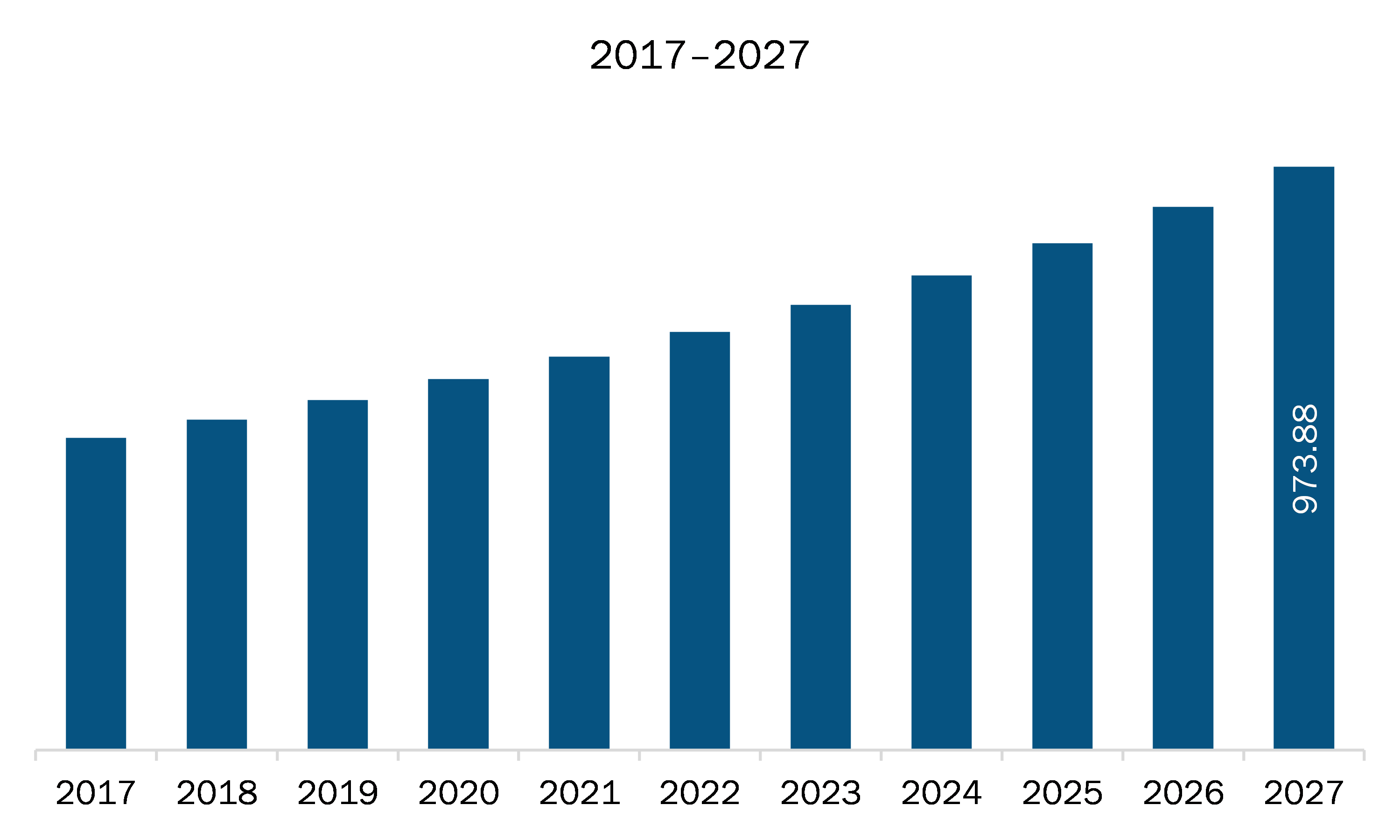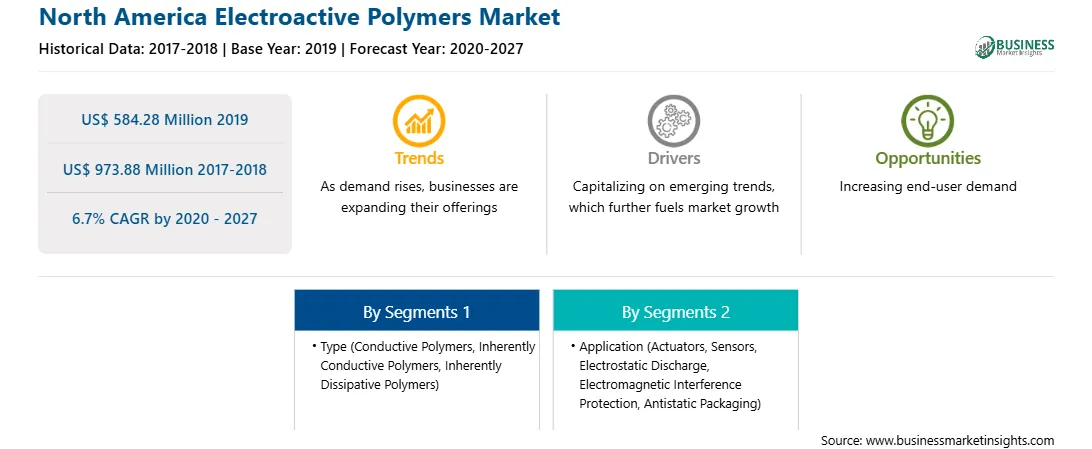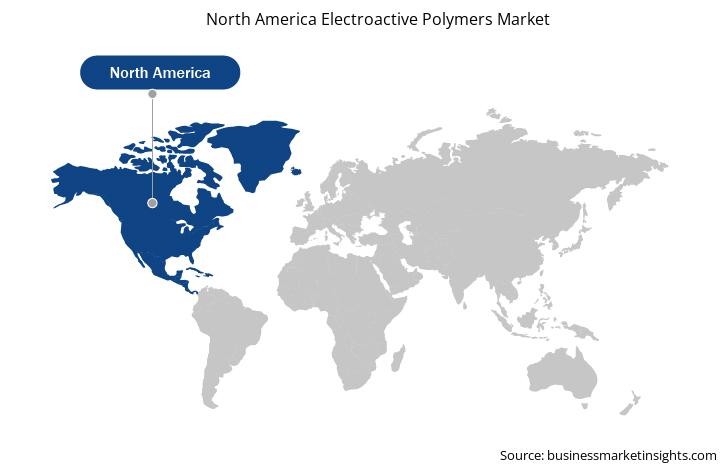The North America electroactive polymers market is a highly fragmented market with the presence of considerable regional and local players providing numerous solutions for companies investing in the market arena. The North American region constitutes developed economies such as US, Canada, and Mexico as a developing nation. Developments in science and technology, especially in the electronics and semiconductors sector, have led to the advent of smart polymers that are capable of changing shape when stimulated by current. Smartphone is a key example of smart electronics that use components made from electroactive polymers, such as batteries, capacitors, proximity sensors, fingerprint sensors, and touchscreen sensors. Electroactive polymers also find use in smart computers, laptops, and tablets. With the ongoing research and development activities, companies are likely to come up with the use of electroactive polymers in computers for blind people via braille. Electroactive polymers are being used in electronic devices to expand the character limit while using braille and thus help the visually impaired people in communicating.
North America, especially the US, witnessed an unprecedented rise in number of COVID-19 cases, which led to the discontinuation of electroactive polymers manufacturing activities; other chemical and materials manufacturing sector has subsequently impacted the demand for electroactive polymers during the early months of 2020. Moreover, decline in the overall manufacturing activities has led to discontinuation of electroactive polymers components manufacturing projects, thereby reducing the demand for electroactive polymers. Similar trend was witnessed in other North American countries such as Mexico and Canada. However, the countries are likely to overcome this drop in demand with the economic activities regaining their pace, especially in the beginning of 2021.

Strategic insights for the North America Electroactive Polymers provides data-driven analysis of the industry landscape, including current trends, key players, and regional nuances. These insights offer actionable recommendations, enabling readers to differentiate themselves from competitors by identifying untapped segments or developing unique value propositions. Leveraging data analytics, these insights help industry players anticipate the market shifts, whether investors, manufacturers, or other stakeholders. A future-oriented perspective is essential, helping stakeholders anticipate market shifts and position themselves for long-term success in this dynamic region. Ultimately, effective strategic insights empower readers to make informed decisions that drive profitability and achieve their business objectives within the market.

| Report Attribute | Details |
|---|---|
| Market size in 2019 | US$ 584.28 Million |
| Market Size by 2027 | US$ 973.88 Million |
| Global CAGR (2020 - 2027) | 6.7% |
| Historical Data | 2017-2018 |
| Forecast period | 2020-2027 |
| Segments Covered |
By Type
|
| Regions and Countries Covered | North America
|
| Market leaders and key company profiles |
The geographic scope of the North America Electroactive Polymers refers to the specific areas in which a business operates and competes. Understanding local distinctions, such as diverse consumer preferences (e.g., demand for specific plug types or battery backup durations), varying economic conditions, and regulatory environments, is crucial for tailoring strategies to specific markets. Businesses can expand their reach by identifying underserved areas or adapting their offerings to meet local demands. A clear market focus allows for more effective resource allocation, targeted marketing campaigns, and better positioning against local competitors, ultimately driving growth in those targeted areas.

The electroactive polymers market in North America is expected to grow from US$ 584.28 million in 2019 to US$ 973.88 million by 2027; it is estimated to grow at a CAGR of 6.7% from 2020 to 2027. The field of biomimetics presents lucrative applications for electroactive polymer companies; the field deals with the models, systems, and elements of nature to solve complex human problems. Under these applications, electroactive polymers are used to mimic the functioning of muscles. The industry is still in a growth stage, witnessing continuous investments in the development of artificial intelligence (AI) with major focus on artificial muscles and vision. Electroactive polymers offer resilience, and large actuation, flexibility, and tolerance to damage due to which they are being used to fabricate muscles with the capabilities of biological muscles. In the recent past, machines have been made that imitate fish, birds, plants, and insects. For instance, Eamex Corporation developed an electroactive polymer-based fish known as floajet. However, the suitable properties of electroactive polymers desired for biomimetic performance such as density, strain, speed, efficiency, and actuation pressure is yet to confirm.
Based on application, the ESD and EMI protection segment accounted for the largest share of the North America electroactive polymers market in 2019. Based on type, the inherently conductive polymer segment held a larger market share of the North America electroactive polymers market in 2019. Side effects caused due to an electrostatic discharge (ESD) is an induced EMI (electromagnetic interference). The effects of undesired electromagnetic radiation or EMI on ungrounded or unshielded conductors are commonly underestimated. An ESD protection device can protect a circuit from an electrostatic discharge (ESD) to prevent a malfunction or breakdown of any electronic device. Electroactive polymers are utilized in such devices for EDS protection since these polymers have high physical & mechanical strength and anti-static properties. The inherently conductive polymer is a family of specialty conductive thermoplastic compounds, which fulfill uniform and precise surface resistivity throughout a resistivity spectrum from strong ESD to strong anti-static. These polymers are quite suited for disk-drive components, wafer processing, and cleanroom applications. They are advantageous in automotive applications needing static discharge protection like fuel system components.
A few major primary and secondary sources referred to for preparing this report on the North America electroactive polymers market are company websites, annual reports, financial reports, national government documents, and statistical database, among others. Major companies listed in the report are include Lubrizol Corporation, Arkema Group, Solvay S.A., Parker Hannifin Corp, Celanese Corporation, Avient Corporation, Agfa-Gevaert Group, Kenner Material & System Co., Ltd. and 3M.
The North America Electroactive Polymers Market is valued at US$ 584.28 Million in 2019, it is projected to reach US$ 973.88 Million by 2027.
As per our report North America Electroactive Polymers Market, the market size is valued at US$ 584.28 Million in 2019, projecting it to reach US$ 973.88 Million by 2027. This translates to a CAGR of approximately 6.7% during the forecast period.
The North America Electroactive Polymers Market report typically cover these key segments-
The historic period, base year, and forecast period can vary slightly depending on the specific market research report. However, for the North America Electroactive Polymers Market report:
The North America Electroactive Polymers Market is populated by several key players, each contributing to its growth and innovation. Some of the major players include:
The North America Electroactive Polymers Market report is valuable for diverse stakeholders, including:
Essentially, anyone involved in or considering involvement in the North America Electroactive Polymers Market value chain can benefit from the information contained in a comprehensive market report.